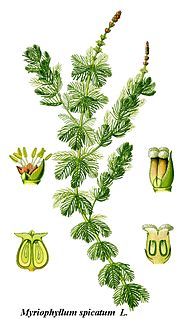
The Magnoliaceae are a flowering plant family, the magnolia family, in the order Magnoliales. It consists of two subfamilies: Magnolioideae, of which Magnolia is the best-known genus, and Liriodendroidae, a monogeneric subfamily, of which Liriodendron is the only genus.

Nymphaeaceae is a family of flowering plants, commonly called water lilies. They live as rhizomatous aquatic herbs in temperate and tropical climates around the world. The family contains five genera with about 70 known species. Water lilies are rooted in soil in bodies of water, with leaves and flowers floating on or emergent from the surface. Leaves are round, with a radial notch in Nymphaea and Nuphar, but fully circular in Victoria and Euryale. It is the national flower of Bangladesh.

The Actinidiaceae are a small family of flowering plants. The family has three genera and about 360 species and is a member of the order Ericales.

Oleaceae, also known as the olive family, is a taxonomic family of flowering shrubs, trees, and a few lianas in the order Lamiales, It presently comprises 28 genera, one of which is recently extinct. The extant genera include Cartrema, which was resurrected in 2012. The number of species in the Oleaceae is variously estimated in a wide range around 700. The flowers are often numerous and highly odoriferous. The family has a subcosmopolitan distribution, ranging from the subarctic to the southernmost parts of Africa, Australia, and South America. Notable members include olive, ash, jasmine, and several popular ornamental plants including privet, forsythia, fringetrees, and lilac.

Smilacaceae, the greenbriers, is a family of flowering plants. While they were often assigned to a more broadly defined family Liliaceae, most recent botanists have accepted the two as distinct families, diverging around 55 million years ago during the Early Paleogene. One characteristic that distinguishes Smilacaceae from most of the other members of the Liliaceae-like Liliales is that it has true vessels in its conducting tissue. Another is that the veins of the leaves, between major veins, are reticulate (net-shaped), rather than parallel as in most monocots.

Amaranthaceae is a family of flowering plants commonly known as the amaranth family, in reference to its type genus Amaranthus. It includes the former goosefoot family Chenopodiaceae and contains about 165 genera and 2,040 species, making it the most species-rich lineage within its parent order, Caryophyllales.

Geraniaceae is a family of flowering plants placed in the order Geraniales. The family name is derived from the genus Geranium. The family includes both the genus Geranium and the garden plants called geraniums, which modern botany classifies as genus Pelargonium, along with other related genera.

The Urticaceae are a family, the nettle family, of flowering plants. The family name comes from the genus Urtica. The Urticaceae include a number of well-known and useful plants, including nettles in the genus Urtica, ramie, māmaki, and ajlai.

Hamamelidaceae, commonly referred to as the witch-hazel family, is a family of flowering plants in the order Saxifragales. The clade consists of shrubs and small trees positioned within the woody clade of the core Saxifragales. An earlier system, the Cronquist system, recognized Hamamelidaceae in the Hamamelidales order.

Gesneriaceae, the gesneriad family, is a family of flowering plants consisting of about 152 genera and ca. 3,540 species in the tropics and subtropics of the Old World and the New World, with a very small number extending to temperate areas. Many species have colorful and showy flowers and are cultivated as ornamental plants.

Ochnaceae is a family of flowering plants in the order Malpighiales. In the APG III system of classification of flowering plants, Ochnaceae is defined broadly, to include about 550 species, and encompasses what some taxonomists have treated as the separate families Medusagynaceae and Quiinaceae. In a phylogenetic study that was published in 2014, Ochnaceae was recognized in the broad sense, but two works published after APG III have accepted the small families Medusagynaceae and Quiinaceae. These have not been accepted by APG IV (2016).

The Thymelaeaceae are a cosmopolitan family of flowering plants composed of 50 genera and 898 species. It was established in 1789 by Antoine Laurent de Jussieu. The Thymelaeaceae are mostly trees and shrubs, with a few vines and herbaceous plants.

Nectar is a sugar-rich liquid produced by plants in glands called nectaries or nectarines, either within the flowers with which it attracts pollinating animals, or by extrafloral nectaries, which provide a nutrient source to animal mutualists, which in turn provide herbivore protection. Common nectar-consuming pollinators include mosquitoes, hoverflies, wasps, bees, butterflies and moths, hummingbirds, honeyeaters and bats. Nectar plays a crucial role in the foraging economics and evolution of nectar-eating species; for example, nectar foraging behavior is largely responsible for the divergent evolution of the African honey bee, A. m. scutellata and the western honey bee.

Haloragaceae is a eudicot flowering plant family in the order Saxifragales, based on the phylogenetic APG system. In the Cronquist system, it was included in the order Haloragales.

Rhodiola is a genus of perennial plants in the family Crassulaceae that resemble Sedum and other members of the family. Like sedums, Rhodiola species are often called stonecrops. Some authors merge Rhodiola into Sedum.
Sladeniaceae is a family of flowering plants containing tree species found in subtropical to tropical environments in East Africa (Ficalhoa), Burma, Yunnan, and Thailand (Sladenia). The family consists of trees with alternate, simple leaves without stipules, and flowers arranged in cymose inflorescences.

Saurauia is a genus of plants in the family Actinidiaceae. It comprises about over 300 species distributed in the tropics and subtropics of Asia and South and Central America. Genetic evidence and the cell biology of the group support monophyly of the genus. Monophyly of the genus is also supported by micromorphological characters and by phylogenetic analysis, although the exact evolutionary relationships of Saurauia with the other two genera of the Actinidiaceae, Actinidia and Clematoclethra, are not well understood. It is also the only extant genus within its family whose natural distribution includes areas outside of Asia.

Cannabaceae is a small family of flowering plants. As now circumscribed, the family includes about 170 species grouped in about 11 genera, including Cannabis, Humulus (hops) and Celtis (hackberries). Celtis is by far the largest genus, containing about 100 species.

Cartonema is a genus of perennial or annual monocotyledonous flowering plants in the dayflower family. It is restricted to Australia and nearby Trangan Island, which is part of Indonesia. It is the earliest diverging member of its family and has a number of traits that are unique within it, such as non-succulent leaves and a lack of raphides. Its distinctive features led to the genus to once be considered part of its own separate family, Cartonemataceae. However, analysis of DNA sequences, as well as many common anatomical characters, has supported its relationship with the Commelinaceae. It contains about 11 species.

Coryloideae is a subfamily in the woody angiosperm family Betulaceae, commonly known as the birch family, and consists of four extant genera - Corylus L., Ostryopsis Decne., Carpinus L., and Ostrya Scop. These deciduous trees and shrubs are primarily distributed in the boreal and cool temperate zones of the Northern Hemisphere, with the majority occurring in Asia, many occurring in North America and a few species occurring as far south as South America. Synapomorphies such reduced staminate flowers, advanced wood anatomy features, and the presence of spermidines in pollen define the Coryloideae.


















